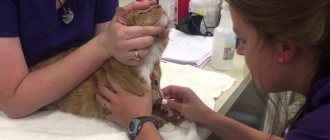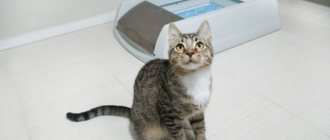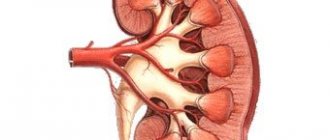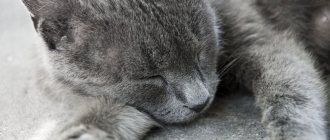- Why a cat’s paw may hurt What to do if a cat’s paw hurts
Pain in cats is always difficult to diagnose. They are very good at hiding pain; often their gait practically does not change in case of any limb injuries. Therefore, it is important to understand that if you see without a special examination that a cat’s paw hurts, or is limping, or does not use it when walking, this most often indicates serious problems and very severe pain. Although there are exceptions. Some cats, on the contrary, with pain syndrome, react excessively to any touch; for example, they may not allow touching their stomach, back and paws, although only one thing hurts.
Why does a cat limp on his front leg: injury
As already mentioned, it is for this reason that a cat begins to limp on its paw most often. If the owners notice that it is difficult for their pet to step on its front paw, they should simply remember if anything has happened recently that could cause the injury. A cat may limp, for example, after an unsuccessful jump. Also, an animal’s paw may begin to hurt after someone steps on it, pinches it in a door, etc. In addition, quite often a similar problem is observed in those cats that are allowed to walk outside. A pet can get injured from other animals, after an unsuccessful jump, etc.
Lameness due to injury can range from mild to severe. In any case, if such a problem is discovered, your pet should be examined first. If the lameness is caused by an injury, a wound or swelling will likely be found on the paw. In this case, the animal owner should just wait a day. Most likely, the cat's injury, if he can still step on his paw, will go away after this time.
If the cat does not stop limping after 24 hours, you should take him to the veterinarian. The doctor will examine the animal, make the correct diagnosis and prescribe treatment.
The reasons why the cat began to limp on its front leg could be:
- cuts and punctures;
- fractures and dislocations;
- splinters.
Also, a cat, for example, can break a claw if it jumps unsuccessfully. In this case, the animal will subsequently experience quite severe pain for a long time and, accordingly, will begin to limp.
The main reasons for the appearance
As a rule, with many joint diseases, the main “effect” of them is the complete or partial destruction of the hyaline cartilage that covers the proximal and distal ends of the bones. Sometimes this happens for no apparent reason, but more often it’s all about age-related changes.
It also happens that inflammatory/degenerative joint lesions develop against the background of secondary infectious diseases, as well as various injuries. But many biologists and veterinarians believe that in cats specifically, many types of these pathologies are of an autoimmune nature. It is precisely because of the “violence” of one’s own defense mechanisms that, for example, rheumatoid arthritis develops.
Arthritis and arthrosis
This problem usually occurs in fairly old animals. In this case, lameness, of course, does not appear suddenly. At first, it becomes only slightly difficult for the pet to step on its foot. Then the problem gets worse.
If a cat has arthritis and is limping on its front leg, what should you do in this case? If there is such a problem, your pet will need to be shown to a specialist. Unfortunately, it is almost impossible to cure arthritis or arthrosis in old animals. The doctor will most likely prescribe only maintenance therapy.
Treatment methods
If a cat is diagnosed with arthritis, it must be treated comprehensively using symptomatic therapy and supportive techniques. It is necessary to improve the quality of keeping the animal by changing the conditions and diet. An integrated approach allows you to reduce pain, support the functions of the musculoskeletal system, and also significantly reduce the risk of complications.
In veterinary medicine, there are several ways to treat arthritis - conservative and surgical. Surgery is performed for cruciate ligament ruptures, joint instability, and severe hip dysplasia.
Emergency surgery is also possible in case of advanced processes with serious complications and in the absence of effectiveness of conservative treatment.
Particular importance in the treatment of arthritis is given to proper care and creation of conditions for the animal. Depending on the pet's breed, age and severity of the violations, the specialist's recommendations will depend. The main conditions are:
- providing an animal diagnosed with arthritis with a special tray with low sides, as well as preventing possible ascents and descents of stairs;
- place bowls for food and water in all places where the animal frequents;
- use special surfaces so that the cat can easily climb onto a chair, bed or sofa (place ottomans or small chairs nearby);
- choose soft, rather than hard, bedding for sleeping, which will make it possible to reduce pain in the joints, and heated bedding is also ideal;
- Regularly brush your pet's fur, making it easier for him to groom himself.
Conservative therapy includes the use of pain medications, a special diet, and joint supplements. The use of physiotherapeutic procedures is also recommended.
To relieve pain in cats with arthritis, non-steroidal anti-inflammatory drugs are used. Uncontrolled use of painkillers in this group can cause side effects, such as anorexia, eruption of gastric contents, stool upset, and intoxication of the body due to impaired renal function.
It is especially important to conduct a blood test for the animal before starting treatment with non-steroidal anti-inflammatory drugs. A biochemical analysis is carried out to determine the amount of creatinine, urea, urea and electrolytes. It is not advisable to use these painkillers in cats with signs of dehydration and impaired functioning of the cardiovascular system.
Elbow dysplasia
This disease occurs in both young and old cats. Unfortunately, purebred animals are especially susceptible to it. Cattery owners often use this method of breeding expensive cats as inbreeding. In this case, kittens are born with pronounced breed characteristics. However, inbreeding significantly increases the risk of offspring developing hereditary diseases. One of these ailments is elbow dysplasia.
Signs of this disease can appear in a pet at a very early age. However, lameness in a cat with this problem becomes most noticeable at 2-3 years of age. Of course, such animals should not be allowed to breed. Also, the cat should definitely be taken to the veterinarian.
Like arthrosis, it is unlikely that it will be possible to cure dysplasia in a pet. However, the doctor will still choose a treatment regimen that will make the cat’s life more comfortable. The main symptoms of this disease in cats, in addition to lameness, are:
- crunching sounds when moving;
- X-shaped curvature of the limbs;
- stiffness of movement when standing up.
Prevalence
However, until relatively recently, this topic was considered highly specialized: it was believed that the same arthritis in cats occurs very rarely and its course, in general terms, is no different from that of dogs. This is partially true, but there are still certain differences.
So how common are joint pathologies in cats? Recent research by European veterinarians has led to phenomenal results. It turned out that according to statistical information collected (since 2002), more than 90% of cats aged 10 to 12 years had all the signs of degenerative destruction of the joints. This also includes cases of spondylosis .
But even when the latter were excluded from the statistics, it turned out that symptoms of joint damage were still clearly observed in at least 2/3 of the study population. Upon closer examination, it turned out that these pathologies are common in 60-90% of cats, depending on their breed, weight, gender and age.
The most common disease is arthritis. The most commonly affected joints are the shoulder, hip, elbow and knee joints. Cases of degenerative destruction of the metatarsal bones have also been reported.
Osteomyelitis in cats
If a domestic cat is limping on its front leg, this may also indicate that it has developed this dangerous disease. The disease in this case also manifests itself gradually. Osteomyelitis is a disease associated with bone necrosis, accompanied by a purulent-inflammatory process.
Most often, this unpleasant disease occurs in cats under the age of 2 years. At the same time, pets of the Persian breed are considered the most susceptible to it. Veterinarians explain this by hereditary predisposition. Osteomyelitis is usually treated comprehensively - through surgery, as well as medications.
Joint diseases
The cat is lethargic, sleeps all the time and eats little: what to do
Also, without visible damage, the cat limps on its hind leg with serious joint diseases. Some of them are congenital and therefore develop slowly. Pathology cannot be detected by a simple examination without medical education. If you pay attention to the accompanying symptoms and promptly contact specialists, the animal can be cured without resorting to surgery.
- Hip dysplasia is a genetic disease. It is dangerous because it can progress even in young cats. Lameness is especially noticeable after prolonged rest (sleep, rest).
- Arthritis and arthrosis are common in older animals. The disease affects bone tissue, causing pathological changes. Due to pain, cats try to move as little as possible, preferring to lie down. They often refuse food and become weak. When palpating swollen joints, they react sharply to pain. The disease may be accompanied by fever.
- Patella patellar luxation, or patellar luxation, is an uncommon problem in cats. It is usually the result of severe trauma, or less commonly a genetic abnormality. It occurs suddenly, causing severe pain in the animal. At the slightest movement of its paw, the cat meows loudly. The injury requires immediate treatment, and in advanced cases, surgery.
Lack of calcium affects the motor functions of kittens
- Osteomyelitis is a disease that occurs in young cats during the phase of active growth and development. Degeneration and partial destruction of bone tissue can affect not only one limb, but all at once. The disease is characterized by acute pain in the pet, which is why even light touches cause aggressive behavior.
- Osteochondrosis, in which pinching and compression of the nerve roots in the spine occurs, causes the animal to limp in any of the four limbs. Wear of the cartilage layer of the intervertebral discs affects the cat’s ability to move easily.
- Osteosarcoma is a malignant neoplasm. Usually it is a pathology of older cats that have crossed the 6-7 year mark.
All of these diseases can only be diagnosed by a doctor at a specialized clinic. They require mandatory treatment with corticosteroids, immunostimulating and painkillers under the supervision of a veterinarian. In severe cases - surgical intervention.
Important! If there is any suspicion of joint disease in cats, you must immediately take your pet to the clinic. Delay or attempts at treatment at home can negatively affect his health and lead to death.
Lameness due to infection
If the cat begins to limp on its front leg, it may have become infected with calcivirus. This disease of an infectious nature is very easily transmitted from a sick animal to a healthy one. For prevention, many cat owners vaccinate them against this disease. Animals that have not been vaccinated can become ill with calcivirus very easily.
In addition to lameness, signs of this disease may include:
- breathing problems;
- conjunctivitis;
- nasal discharge;
- damage to the paw joints;
- the presence of ulcers on the mucous membranes.
This disease causes inflammation of the anterior joint chambers. This is why the cat is limping on his front leg. What should owners do in this case? If you have calcivirosis, the animal should, of course, be shown to a specialist. Treatment in this case is complex - therapeutic and symptomatic.
Another infection that can cause lameness in a cat is a fungus. In this case, dermatophytes often affect not only the animal’s pads or its skin, but also its claws or joints. Lameness in cats in this case develops due to inflammation.
Injuries and lameness
The obvious cause of lameness is injury to a pet's paw. A cat can protect a limb for the following reasons:
- Splinter in the paw pad.
- Injury.
- Sprain.
- Damage to claws.
It is important to try to recall in memory all the events preceding the onset of lameness. If the cat fought with other animals or fell from a great height, the paw hurts due to a bruise or sprain.
A splinter caught in the foot pad can cause severe discomfort. In this case, the cat cannot remove a small foreign body on its own. Since acute pain is felt when putting pressure on the damaged paw, the animal begins to protect it, which is why lameness appears.
The cat does not step on its front paw due to damaged claws. This can also happen if you fall from a great height or get hit. In addition, if someone accidentally steps on a cat's paw, the claw may be broken, which causes the animal a lot of discomfort.
Pretense
Sometimes it happens that the animal has no visible injuries, but the cat still limps on its front leg. The reason in this case may simply be the nature of the animal. A pet whose paw is slightly pinched or, for example, stepped on, may be offended. In this case, the cat, even if it does not feel any discomfort in its paw, begins to limping demonstratively only in order to express its indignation to its owners.
If the lameness is simply emotional, there will most likely be no damage to the animal's paw. Moreover, after a couple of hours the cat will get tired of playing, and he will stop limping.
Causes of pain in the paw
Most often, the causes of pain in the paws of an animal are associated with injuries and pathology of the joints, much less often with neurology. Inflammatory diseases can also be the cause.
Arthrosis and arthritis
These are inflammatory and degenerative diseases of the joints, accompanied by pain and stiffness. Scottish and British cats are more prone to this than other breeds. Fold-eared animal breeds are more likely to suffer from arthrosis than their straight-eared relatives.
Injuries
This can be a bruise, a displacement of a joint, a puncture of a bone, a puncture of the soft tissue of the paw or a splinter, a sprain of the ligamentous apparatus and a fracture. Injuries are usually accompanied by the formation of hematomas at the site of injury, tissue swelling, and severe pain. The animal does not allow the paw to be examined. Injuries include burns and frostbite. When the paw pads are slightly frostbitten, they turn white. Blisters may form. When a burn occurs, a blister or ulcer appears at the site of chemical contact, and hair falls out.
Myositis
Inflammatory disease of muscle tissue. Accompanied by muscle spasm at the site of the lesion (the tissue feels dense and painful to the touch). Rarely seen in cats.
Osteoporosis
Bone loss (bone resorption). The disease is accompanied by lethargy of the animal, reluctance to move actively, and frequent fractures.
Osteomyelitis
This is an inflammatory disease, a purulent-necrotic process that affects both the bone marrow and bone tissue. A serious disease for cats, it occurs with an increase in body temperature and general weakness. The animal may refuse to feed and keeps its paw suspended when moving. If the cat is forced to lean on it, it limps heavily and meows in pain.
Pododermatitis
This is an inflammatory-infectious disease of the cat's paw pads. Its cause may be temperature factors (frostbite) or infections (bacterial and fungal).
Radiculitis
Radiculitis is not a common problem in cats. But older animals can “earn” this disease. In this case, the animal limps, drags its paw, and moves with difficulty. The pain is localized in the back and radiates to the paw.
In what cases should a cat be taken to the veterinarian?
When is specialist help needed? When the animal exhibits at least one of the following symptoms:
- the cat cannot walk at all or moves with great difficulty;
- when you touch the paw, the pet meows and abruptly pulls it away;
- the cat does not step on its paw, tucking it in when moving.
It is also worth visiting a specialist if the cat’s lameness is accompanied by loss of appetite, high fever, increased fatigue, lethargy or aggression. These are already very alarming symptoms.
Why might a cat shake its paw or pull it back?
Sometimes cat/cat breeders notice that the pet is shaking its paw or pulling it back.
This can happen for several reasons:
- Ticks. The parasites attach themselves to the soft pad on the paw and burrow into the flesh. This causes severe discomfort to the animal, so the cat shakes the limb to relieve the pain. The pet owner can detect the tick by visually inspecting the paw and remove it.
- Worms . The appearance of helminthic parasites in an animal’s body can be noticed by the following symptoms: the cat is constantly restless, shakes one or the other paw, and sometimes eats poorly. Worm eggs can also enter the human body when he caresses or kisses a pet, so medical consultation is extremely important here.
- Inconvenience after sterilization. After sterilization, a special blanket is put on the animal to prevent licking the healing scar. It usually bothers cats, and they try to remove it in every possible way. At the same time, they can shake their hind legs.
- Scotch tape, glue, chewing gum, splinter. Cats, especially those who walk outside, often catch pieces of adhesive tape, chewing gum, resin, splinters, etc. on their paws. Sensing a foreign object on the pad, the pet shakes the limb in an attempt to get rid of it.
Be sure to read:
Rhinotracheitis in cats: symptoms and treatment, causes, how it is transmitted, best remedies, vaccination
The cat is limping on his front leg. What to do in this case, how to provide first aid to your pet?
As already mentioned, a limping animal should be left alone for one day and then taken to a veterinarian. Also, if a bruise is revealed during examination, you can apply cold to the affected area for 1 minute, wait 20 seconds and apply again for 1 minute. This operation should be repeated for 5 minutes.
If the owners suspect that the cat has a fracture, he needs to try to fix the paw. In this case, the animal must be taken to the clinic in an immobilized state. You can also try to provide first aid to a cat if he has a minor wound. In this case, the affected area must be carefully cleaned from dirt with a cloth soaked in soapy water. After this, the wound should be treated with furatsilin solution and the animal should be taken to the veterinarian.
First aid for a cat
If you notice lameness in your pet, immediately identify the cause of the problem. If the wound is open, you need to disinfect it by removing the hair around the injury and rinsing the lesion with a solution of furatsilin. After this, apply a sterile bandage and take it to the veterinarian.
In case of a fracture, dislocation, or sprain, immobilize the animal as much as possible, ensuring complete rest, injecting an anesthetic and urgently calling a doctor.
Avoid self-medication! At the clinic, the doctor will take an x-ray and make a diagnosis. If necessary, a fixative bandage is applied; in difficult situations, a splint or plaster cast is used. The animal is given anti-inflammatory drugs and antibiotics.











